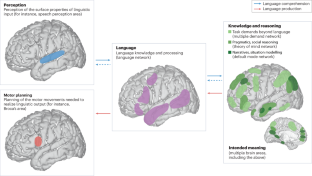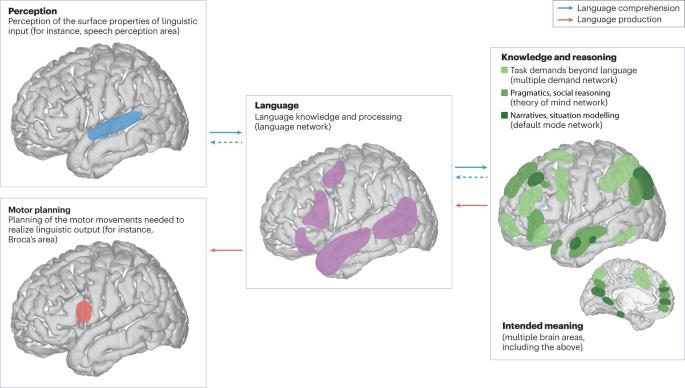The language network as a natural kind within the broader landscape of the human brain
IF 28.7
1区 医学
Q1 NEUROSCIENCES
引用次数: 0
Abstract
Language behaviour is complex, but neuroscientific evidence disentangles it into distinct components supported by dedicated brain areas or networks. In this Review, we describe the ‘core’ language network, which includes left-hemisphere frontal and temporal areas, and show that it is strongly interconnected, independent of input and output modalities, causally important for language and language-selective. We discuss evidence that this language network plausibly stores language knowledge and supports core linguistic computations related to accessing words and constructions from memory and combining them to interpret (decode) or generate (encode) linguistic messages. We emphasize that the language network works closely with, but is distinct from, both lower-level — perceptual and motor — mechanisms and higher-level systems of knowledge and reasoning. The perceptual and motor mechanisms process linguistic signals, but, in contrast to the language network, are sensitive only to these signals’ surface properties, not their meanings; the systems of knowledge and reasoning (such as the system that supports social reasoning) are sometimes engaged during language use but are not language-selective. This Review lays a foundation both for in-depth investigations of these different components of the language processing pipeline and for probing inter-component interactions. Many brain areas support complex language processing behaviours. In this Review, Fedorenko et al. disentangle the ‘core’ language system as functionally distinct from the perceptual and motor brain areas and knowledge and reasoning systems it closely interacts with during language comprehension and production.


语言网络是人脑大环境中的一个自然种类
语言行为是复杂的,但神经科学证据将其分解为由专门脑区或网络支持的不同组成部分。在这篇综述中,我们描述了 "核心 "语言网络,其中包括左半球额叶和颞叶区域,并表明它具有很强的相互关联性,独立于输入和输出模式,对语言具有重要的因果关系和语言选择性。我们讨论的证据表明,这个语言网络可以存储语言知识,支持与从记忆中获取单词和结构有关的核心语言计算,并将它们结合起来以解释(解码)或生成(编码)语言信息。我们强调,语言网络与较低层次的感知和运动机制以及较高层次的知识和推理系统密切配合,但又相互区别。感知和运动机制处理语言信号,但与语言网络不同的是,它们只对这些信号的表面属性而非其含义敏感;知识和推理系统(如支持社会推理的系统)有时会在语言使用过程中参与,但并不具有语言选择性。本综述为深入研究语言处理管道的这些不同组成部分以及探究各组成部分之间的相互作用奠定了基础。
本文章由计算机程序翻译,如有差异,请以英文原文为准。
求助全文
约1分钟内获得全文
求助全文
来源期刊

Nature Reviews Neuroscience
NEUROSCIENCES-
自引率
0.60%
发文量
104
期刊介绍:
Nature Reviews Neuroscience is a multidisciplinary journal that covers various fields within neuroscience, aiming to offer a comprehensive understanding of the structure and function of the central nervous system. Advances in molecular, developmental, and cognitive neuroscience, facilitated by powerful experimental techniques and theoretical approaches, have made enduring neurobiological questions more accessible. Nature Reviews Neuroscience serves as a reliable and accessible resource, addressing the breadth and depth of modern neuroscience. It acts as an authoritative and engaging reference for scientists interested in all aspects of neuroscience.
 求助内容:
求助内容: 应助结果提醒方式:
应助结果提醒方式:


